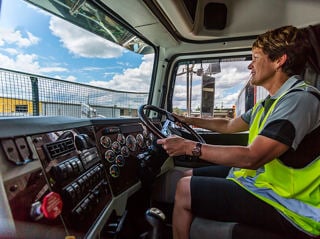Philip van der Wilt, vice president EMEA, at Samsara
The UK has just kicked off a major recruitment drive to attract new talent into the logistics industry. And not before time.
Generation Logistics leans heavily towards leading edge advancements in technology — in areas such as artificial intelligence (AI), robotics, and even parcel-carrying drones — as it seeks to enthuse and recruit the next generation of talent. But that is all geared for the future.
To address the issues faced today, there needs to be a wholesale change in attitude towards a sector that has been chronically underserved, and yet is strategically important to the future of the UK economy.
Part of that is the recognition of the role technology can play — both in the short term and in the future.
The question for many people, though, is what does that mean in practice? How can technology be used to keep drivers in the industry and help in the recruitment of new blood?
The simple answer is that in many cases, it means removing the hassle around driving jobs, such as paperwork and other administrative tasks by moving to digital processes.
It means installing tech such as cameras that improves the safety of drivers so that they are fully protected in the event of an accident or incident.
And it means introducing technology to improve job satisfaction as part of plans to retain existing staff and attract new recruits.
Automating previously time-consuming tasks
One of the key benefits is that replacing manual processes with handheld digital devices and easy-to-use apps can eliminate hours of unnecessary admin not only for drivers, but for everyone who works across the supply chain.
By digitising ordering, delivery, fulfilment customs forms, and compliance, what used to take hours can now take minutes.
Instead of using a clipboard and pen for driver walkarounds, phone-based apps can capture all the important data — including photos if needed — and log this centrally without any further hold-ups.
Equally, digital documentation means that drivers can capture photos, take notes, and log electronic signatures when completing deliveries simply by using a smartphone or tablet.
In effect, it’s arming staff with the type of smart tech that people in other industries have been using for years.
Because this technology is so simple to use, it allows industry veterans –— and newcomers — to get up to speed with workflows, processes, and administrative tasks much faster than tiresome paper-based services.
But one of the biggest areas where technology is making a real impact is around improving driver safety.
Technology improving driver safety
Plug-in-and-play dash cams automatically capture high-definition video before sending the footage by a wireless connection to be stored centrally.
This real-time visibility of incidents that happen on the road means that when it comes to driver safety, employers have got their back.
Since vehicles have GPS tracking and wireless connectivity, the installation of panic buttons means that drivers can alert fleet managers and send out a call for help if there’s a problem.
Armed with an exact location — and, in some cases, instantly uploaded video footage of an incident — it means fleet managers can coordinate a response and involve emergency services if needed.
AI can also be used to provide alerts to drivers while they’re out on the road, helping to prevent incidents and accidents before they happen.
In effect, it’s like having another pair of eyes alongside a driver to help avoid issues such as speeding, tailgating, or heavy braking.
With all this information available, it can help provide ongoing training for drivers to keep them safe.
In fact, there are plenty of firms that run driver recognition and reward schemes based on the information that is captured by this technology.
In other words, driver-focused technology can help to foster an end-to-end culture of safety within a fleet, helping to make it an attractive career option for people of all ages and all walks of life.
Above all, the addition of technology means that drivers are never on their own even when they’re working nights, driving abroad or parked up in a layby.
In fact, 95% of the operations leaders involved in our recent Connected Operations Report said AI and automation had led to increased employee retention, as staff benefit from greater upskilling opportunities, increased safety, more autonomy, and less time spent on repetitive tasks.
By removing the hassle factor from paperwork and using technology to improve driver safety, there is little doubt that technology can help to attract and retain staff.





















Login to comment
Comments
No comments have been made yet.